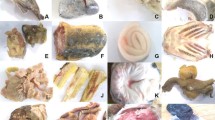Abstract
Oligosaccharides in Atractylodes macrocephala Koidz. (AMK) have a wide range of clinical effects, especially in terms of improving immunity. In this study, the oligosaccharide fingerprint of AMK was first established by high-performance liquid chromatography coupled with evaporative light-scattering detection. This method was confirmed to be accurate and reliable. Twenty-six batches of samples from four regions were detected, and the oligosaccharide fingerprint similarity of AMK was evaluated (> 0.900). Second, the oligosaccharide profile of AMK was analyzed using high-performance liquid chromatography coupled to high-resolution tandem mass spectrometry. Fourteen inulin-type oligosaccharides with a degree of polymerization of 2–15 were identified, including sucrose, 1-kestose, and nystose. Finally, two representative compounds, 1-kestose and nystose, were selected for quantification analysis. The established method had good regression equations, precision, repeatability, and stability. The average contents of 1-kestose and nystose were 0.688% and 0.827%, respectively. This study provides valuable information on the quality evaluation and discrimination of different varieties of AMK.






Similar content being viewed by others
References
Commission, C.P. Chinese Pharmacopoeia (2020) China Medical Scientific and Technological Press. Beijing
Wang R, Zhou G, Wang M, Peng Y, Li X (2014) The metabolism of polysaccharide from Atractylodes macrocephala Koidz. and its effect on intestinal microflora. Evid-Based Complement Altern Med 2014:926381–926387
Li X, Liu F, Li Z, Ye N, Huang C, Yuan X (2014) Atractylodes macrocephala polysaccharides induces mitochondrila-mediated apoptosis in glioma C6 Cells. Int J Biol Macromol 66:108–112
Lim H, Lee JH, Kim J, Kim YS, Kim HP (2012) Effects of the rhizomes of Atractylodes japonical and atractylenolide I on allergic response and experimental atopic dermatitis. Arch Pharmacal Res 35:2007–2012
Zhu Bo, Zhang Q, Hua J, Cheng W, Qin L (2018) The traditional uses, phytochemistry, and pharmacology of Atractylodes macrocephala Koidz.: a review. J Ethnopharmacol 226:143–167
Zhang Y, Bo C, Fan Y, Long Chen R, Zhang Y, hong Wang X (2018) Qualitative and quantitative determination of Atractylodes rhizome using ultra performance liquid chromatography coupled with linear ion trap-Orbitrap mass spectrometry with data-dependent processing. Biomed Chromatogr 33:4443
Chen Q, Li P, Zheng F, He J, Yi Y (2011) Validated Method for the quantification of atractylenolide III in different processed products of Rhizome Atractylodes Macrocephalae. Phytochem Anal 22:10–13
Cui Y-S, Li Y-X, Jiang S-L, Song A, Zheng Fu, Dong C, Yao Z, Qiao W (2020) Isolation, purification, and structural characterization of polysaccharides from Atractylodis Macrocephalae Rhizoma and their immunostimulatory activity in RAW264.7 cells. Int J Biol Macromol 163:270–278
Feng Y-Y, Ji H-y, Dong X-D, Liu A (2019) An alcohol-soluble polysaccharide from Atractylodes macrocephala Koidz. induces apoptosis of Eca-109 cells. Carbohyd Polym 226:115136–115143
Lin B, Li W, Tian Y, Guo S, Huang Y, Danning Xu, Cao N (2019) Polysaccharide of Atractylodes macrocephala Koidz enhances cytokine secretion by stimulating the TLR4-MyD88-NF-κB signaling pathway in the mouse spleen. J Med Food 9:937–943
Zhe L, Liu Y, Yang Qu, Shi L, Dou D, Kuang H (2015) Characterisation of oligosaccharides from Baizhu by HILIC-MS. Nat Prod Res 28:1194–1200
Sun X, Cui X-B, Wen H-M, Shan C, Wang X, Kang An, Cai C, Li W (2017) Influence of sulfur fumigation on the chemical profiles of Atractylodes macrocephala Koidz. evaluated by UFLC-QTOF-MS combined with multivariate statistical analysis. J Pharm Biomed Anal 141:19–31
Qiu Z-K, Liu C-H, Gao Z-W, Jiali He Xu, Liu QW, Chen J (2016) The inulin-type oligosaccharides extract from Morinda officinalis, a traditional Chinese herb, ameliorated behavioral deficits in an animal model of post-traumatic stress disorder. Metab Brain Dis 31:1143–1149
Zhu J, Peng Q, Yi Xu, Hexiang Xu, Wan Y, Li Z, Qiu Y, Xia W, Guo Z, Li H, Jin H, Bo Hu (2020) Morinda officinalis oligosaccharides ameliorate depressive-like behaviors in poststroke rats through upregulating GLUT3 to improve synaptic activity. FASEB J 34:13376–13395
Zhao B, Wang X-Y, Liu H, Lv C, Jinca Lu (2020) Structural characterization and antioxidant activity of oligosaccharides from Panax ginseng C.A. Meyer. Int J Biol Macromol 150:737–745
Jiao L, Zhang X, Li Bo, Liu Z, Wang M, Liu S (2014) Anti-tumour and immunomodulatory activities of oligosaccharides isolated from Panax ginseng C.A. Meyer. Int J Biol Macromol 65:229–233
Moro TMA, Clerici MTPS (2020) Burdock (Arctium lappa L) roots as a source of inulin-type fructans and other bioactive compounds: current knowledge and future perspectives for food and non-food applications. Food Res Int 141:109889–109930
Acknowledgements
This study was financially supported by National Development and Reform Commission standardization project of traditional Chinese medicine (NO: ZYBZH-C-JS-33). Thank you for the help in instrumental analysis provided by Center for Instrumental Analysis of Nanjing University of Chinese Medicine.
Author information
Authors and Affiliations
Corresponding author
Ethics declarations
Conflict of interest
The authors declare that they have no known competing financial interests or personal relationships that could have appear to influence the work reported in this paper.
Ethical approval
This article does not contain any studies with human participants or animals performed by any of authors.
Additional information
Publisher's Note
Springer Nature remains neutral with regard to jurisdictional claims in published maps and institutional affiliations.
Supplementary Information
Below is the link to the electronic supplementary material.
Rights and permissions
About this article
Cite this article
Liu, N., Shu, Y., Yan, Yy. et al. Oligosaccharide Profile Analysis and Quality Control of Atractylodes macrocephala Koidz. Using HPLC-HRMS/MS and a Simple HPLC-ELSD Method. Chromatographia 85, 47–54 (2022). https://doi.org/10.1007/s10337-021-04107-x
Received:
Revised:
Accepted:
Published:
Issue Date:
DOI: https://doi.org/10.1007/s10337-021-04107-x




